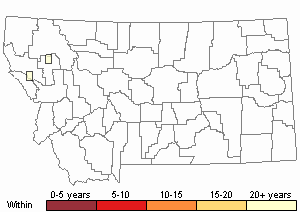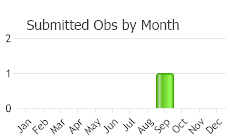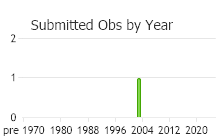View in other NatureServe Network Field Guides
NatureServe
Montana
Utah
Wyoming
Idaho
Wisconsin
British Columbia
South Carolina
Yukon
California
New York
Textured Lungwort Lichen - Lobaria scrobiculata
Other Names:
Lobarina scrobiculata
State Rank Reason (see State Rank above)
Lobaria scrobiculata is a circumpolar boreal lichen that within the Pacific Northwest is rare east of the Cascade Range (McCune and Geiser 2023). In Montana, it is known from a small number of occurrences where it is restricted to sheltered mossy rock outcrops, often near streams or lakes. Current data on known locations, population sizes, threats, trends, and other information is needed.
General Description
GROWTH FORM: Foliose
THALLUS: Medium to large, usually 2-10 cm broad. Lobes broad, rounded, usually 1-5 cm wide. Upper surface yellowish-tinged, pale green to olive gray (dry), dark gray (wet), weakly ridged or undulating. Upper cortex often scabrous near the lobe tips, but lacking tiny hairs. Lower surface smooth or rugose, not distinctly veined, and with dense, fine, and short hairs (tomentose) interrupted by bare patches. Tomentum present throughout lower surface, often blackening. Rhizines usually abundant in cluster, to 3 mm long. Sources: Thomson 1984; McCune and Geiser 2023
PHOTOBIONT: Cyanobacterial. Layer appears dark-colored. Sources: McCune and Geiser 2023
REPRODUCTIVE TYPES: Sorediate. Apothecia rare. Sources: McCune and Geiser 2023
CHEMICAL REACTIONS: Spot tests often weak. Cortex KC+ yellow; medulla K+ yellow to orange, P+ orange (rarely P-), C-, KC+ red. Sources: McCune and Geiser 2023
TAXONOMY & NOMENCLATURE
Lobaria scrobiculata was initially recognized and described as Lichen scobiculatus by Giovanni Antonio Scopoli (latinized as Johannes Antonius Scopolius; 1723-1788), a professor of chemistry and botany in Italy (Yoshimura and Isoviita 1969; Wikipedia 2025a). In 1772, G.A. Scopoli took the specific epithet of scrobiculatus from a descriptive phrase used by Dillenius who also drew the lichen. Yoshimura and Isoviita (1969) researched the process to determine a standard scientific name and authorship (typification) for Lobaria scrobiculata. They provide the evidence for using Dillenius’ drawing from 1741 which is based on a herbarium specimen housed at Oxford University (OXF) to serve as the lectotype because the Type specimen has never been found; it is assumed that Scopoli's specimens were lost in a housefire or shipwreck (Yoshimura and Isoviita 1969). They determined that the correct citation should be Lobaria scrobiculata (Scop.) DC.
The common name “lung wort” refers to their physical shape which resembles the lungs of a human being (Wikipedia 2025b).
Indigenous Yup’ik people in Alaska may call Lobaria scrobiculata Qelquaq (Brodo et al. 2001).
Diagnostic Characteristics
Montana has six
Lobaria species, of which all but one is categized as a state Species of Concern. They are distinguished by the following characteristics:
Lobaria scrobiculata - Textured Lungwort, SOC
* Growth Form: Large foliose.
* Upper Surface: Yellowish-tinged pale green to olive (dry). Weakly reticulate-ridged or undulating
* Reproduction: Sorediate. Apothecia rare.
* Photobiont: Cyanobacterial. No internal cephalodia.
* Lower Surface: Coarsely mottled in color. Densely tomentose with bare whitish patches. Small, white spots (pseudocyphellae) are lacking.
* Chemistry: Medulla K+ yellow to orange, KC+ red
* Note: Closest look-alike to
L. hallii, especially when wet.
Lobaria amplissima - Large Lungwort, SOC
* Growth Form: Minutely fruticose and erect. Tiny.
* Upper Surface: Creamy tan to pale grayish tan (dry). Smooth to irregularly wrinkled.
* Reproduction: Lacking apothecia and soredia.
* Photobiont: Cyanobacterial.
* Lower Surface: Coarsely mottled in color. No small, white spots (pseudocyphellae).
Lobaria anomala - Netted Lungwort, SOC
* Growth Form: Large foliose.
* Upper Surface: Light or dark brown (dry) with a network of ridges.
* Reproduction: White, gray, or blue-gray soredia on ridges of upper surface.
* Photobiont: Cyanobacterial.
* Lower Surface: Coarsely mottled in color. Light brown tomentum with scattered small, white spots (pseudocyphellae).
* Chemistry: Cortex K-. Medulla K- or K+ yellow.
Lobaria hallii - Gray Lungwort, SOC
* Growth Form: Large foliose.
* Upper Surface: Steel Gray - gray to brownish gray (dry). Rough and scabrous with often sparse tiny
and fine hairs (tomentum) – use strong hand-lens to examine towards lobe tips.
* Reproduction: Soredia occur in roundish soralia on surface and margins. Apothecia uncommon.
* Photobiont: Cyanobacterial.
* Lower Surface: Pale brown or whitish tomentum.
* Chemistry: Medulla K-
* Note: Closest look-alike to
L. scrobiculata, especially when wet.
Lobaria linita - Cabbage Lungwort, SOC
* Growth Form: Large foliose.
* Upper Surface: greenish to brownish or brownish gray
* Reproduction: Lacking soredia, isidia, or lobules. Apothecia common.
* Photobiont: Green algal. Internal cephalodia with cyanobacteria.
* Lower Surface: Tomentum light-colored with pale bare swellings. Black veins.
* Chemistry: Medulla K-
Lobaria pulmonaria - Lungwort
* Growth Form: Large foliose.
* Upper Surface: pale greenish to olive or brownish (dry). Strongly and coarsely reticulate-ridged.
* Photobiont: Green algal. Internal cephalodia with cyanobacteria.
* Lower Surface: Light-colored, tomentose with bare swellings.
* Reproduction: Sorediate and/or isidiate. Lobules sometimes present on older individuals. Apothecia uncommon.
* Chemistry: Medulla K+ yellow to orange, KC-
Range Comments
Lobaria scrobiculata is a circumpolar boreal lichen (Thomson 1984). In North America its
distribution includes Alaska south to northern California and east to Montana (McCune and Geiser 2023); portions of the Appalachian Mountains; along Lake Superior in Canada; northeastern coastal areas of the USA and Canada; and other locations (Brodo et a. 2001). In the Pacific Northwest Lobaria scrobiculata is considered rare east of the Cascade Range (McCune and Geiser 2023).
Observations in Montana Natural Heritage Program Database
Number of Observations: 7
(Click on the following maps and charts to see full sized version)
Map Help and Descriptions
Relative Density

Recency



 (Observations spanning multiple months or years are excluded from time charts)
(Observations spanning multiple months or years are excluded from time charts)
Habitat
Lobaria scrobiculata appears to have a strongly oceanic affinity (Thomson 1984). East of the Cascade Range, Lobaria scrobiculata is restricted to sheltered mossy outcrop areas, often near lakes or streams (McCune and Geiser 2023). Lichens are firmly attached to their substrates, which include the bases of trees, shrub, and mossy rocks, and rarely is found on ground or soil in the Pacific Northwest (McCune and Geiser 2023).
Ecology
NITROGEN FIXATIONLobaria scrobiculata is a cyanolichen, which can fix atmospheric nitrogen into forms usable by plants and animals (McCune and Geiser 2023). In
Lobaria scrobiculata, the cyanobacteria belong to genus
Nostoc (Thomson 1984). Cyanobacteria are pigmented ‘blue green’, when seen through a microscope.
AIR QUALITYLichens are indicators of air quality. They obtain their nutrients and also acquire contaminants (pollutants) from the atmosphere. Lichen species also differ in their requirements for particular nutrients and their sensitivities to specific pollutants. The lichen’s tissue can be analyzed for a particular pollutant which summarizes or indicates its level in the air. The community of lichen species can also be used to defer information about a site’s air quality. More information can be found online for the US Forest Service:
Monitoring Lichens;
National Lichens & Air Quality Database; and
National Atlas of Epiphytic Lichens (Jovan et al. 2021a/b); and in McCune and Geiser (2023).
Lobaria scrobiculata is rated as an oligotroph with an optimal nitrogen deposition of 0.8 kg/ha/year (McCune and Geiser 2023). As an oligotroph the lichen is most abundant where deposition averages between 0.5 to 4.2 kg of nitrogen per hectare per year; it becomes increasingly harder to find where nitrogen deposition exceeds 4.2 kg/ha/yr (USFS 2025).
CHEMICAL COMPOUNDSLichens produce primary and secondary chemical compounds that provide a variety of essential and specialized roles (McCune and Geiser 2023). Readers are encouraged to consult Nash (1996) and McCune and Geiser (2023) for more information.
Compounds found in
Lobaria scrobiculata include: Constictic, Norstictic, Stictic, and usnic acids and scrobiculin (Goward et al. 1994).
Norstictic acid is a secondary compound that has properties to be an antioxidant, antimicrobrial, and anti-cancer (McCune and Geiser 2023).
Stictic acid is a secondary compound that has properties to be an antioxidant, antimicrobrial, anti-herbivory, and anti-cancer (McCune and Geiser 2023). In experiments studying the defense mechanisms of lichens to gastropods, stictic acid in
Lobaria scrobiculata was found to be evenly distributed among reproductive and non-reproductive structures and at levels 2-3 times lower than for
Lobaria pulmonaria, a close relative (Asplund et al. 2010b). Researchers concluded that these species differ in their defense strategies to gastropods.
Lobaria scrobiculata concentrates the synthesis of meta-scrobiculin in its reproductive tissues and allocates to all tissues lower levels of usnic acid for its general defense. Whereas,
Lobaria pulmonaria, which lacks meta-scobiculin synthesizes significantly higher concentrations of stictic acid in all tissues to generally defend itself (Asplund et al. 2010a and 2010b).
Usnic acid is a secondary compound that has properties to be an antioxidant, antimicrobrial, allelopathic, cytotoxic, anti-herbivory, anti-cancer, anti-inflammatory, neuroprotective, and analgesic/anti-pyretic; it also acts as a light screen to absorb UV either by absorbing and then re-radiating as heat or in pigments which differentially absorb or reflects at visible wavelengths (McCune and Geiser 2023). In experiments studying the defense mechanisms of lichens to gastropods, usnic acid in
Lobaria scrobiculata was found to be more abundant in the upper cortex (non-reproductive tissue) and absent in soralia (reproductive tissue) (Asplund et al. 2010b). The study concluded that for
Lobaria scrobiculata usnic acid functions as a solar radiation screen for cyanobacteria that underly the cortex, rather than as a defense against herbivores (Asplund et al. 2010b).
Scrobiculin is a secondary defense compound used to deter gastropods in
Lobaria scrobiculata (Asplund et al. 2010b). In experiments studying the defense mechanisms of lichens to gastropods, meta-scrobiculin in
Lobaria scrobiculata was found at levels five times higher in the soralia than in adjacent thallus tissue that lacked reproductive structures (Asplund et al. 2010b). Snails were found to definitively avoid the well-defended soralia. When meta-scrobiculin was removed from
Lobaria scrobiculata, which can be done on living lichens through an acetone rinsing process, the snails fed more on the soralia and less on the non-reproductive tissue. This indicated that the risk of damage to reproductive tissue was greater for
Lobaria scrobiculata. Further, meta-scrobiculin increases the survival rate for dispersing soralia that develop into juvenile thalli. Researchers proposed that
Lobaria scrobiculata uses a strategy that targets the synthesis of defense compounds only in its reproductive structures (Asplund et al. 2010b).
SNAIL-LICHEN INTERACTIONSLobaria scrobiculata is known to be very palatable to gastropods (slugs and snails) living in Norway forests – where it often is observed bearing numerous grazing marks (Asplund et al. 2010a and 2010b). Snail herbivory of soralia, the lichen’s reproductive structure, is deterred significantly by meta-scrobiculin, a secondary defense chemical. In Norway, the lichen-feeding snail,
Cochlodina laminata exhibits different grazing patterns based on the presence or levels of a lichen species’ secondary chemical compounds (Asplund et al. 2010b). See CHEMICAL COMPOUNDS subsection for details.
Reproductive Characteristics
Lobaria scrobiculata propagates predominantly through vegetative (asexual) diaspores: soredia. Occasionally, sexual reproduction of the fungus occurs by spores produced from an apothecium.
SYMBIOTIC PROPAGULES
Soredia propagate the whole lichen, asexually, without re-lichenization (Budel and Scheidegger in Nash [ed.] 1996). Soredia are found on the upper surface of the thallus in specific structures called soralia. For Lobaria scrobiculata soredia are formed from the proliferation of the cyanobacterial and medullary fungal layers of the parent lichen.
GENERATIVE REPRODUCTION
Apothecia are cup- or disk-shaped fruiting bodies on the thallus in which spores, sexual reproduction of the fungus, develop (Budel and Scheidegger in Nash [ed.] 1996). For Lobaria scrobiculata, apothecia are seldom produced (McCune and Geiser 2023).
Stewardship Responsibility
Threats or Limiting Factors
Threats to Lobaria scrobiculata have not been identified.
References
- Literature Cited AboveLegend:
 View Online Publication
View Online Publication Asplund, Johan, Knut Asbjorn Solhaug, and Yngvar Gauslaa. 2010. Optiomal defense: Snails Avoid Reproductive Parts of the Lichen Lobaria scrobiculata Due to Internal Defense Allocation. Ecology 91(10), pp 3100-3105.
Asplund, Johan, Knut Asbjorn Solhaug, and Yngvar Gauslaa. 2010. Optiomal defense: Snails Avoid Reproductive Parts of the Lichen Lobaria scrobiculata Due to Internal Defense Allocation. Ecology 91(10), pp 3100-3105. Asplund, Johan, Per Larsson, Steinar Vatne, and Yngvar Gauslaaa. 2010. Gastropod Grazing Shapes the Vertical Distribution of Epiphytic Lichens in Forest Canopies. Journal of Ecology, 98, 218-225
Asplund, Johan, Per Larsson, Steinar Vatne, and Yngvar Gauslaaa. 2010. Gastropod Grazing Shapes the Vertical Distribution of Epiphytic Lichens in Forest Canopies. Journal of Ecology, 98, 218-225 Brodo, I.M., S. D. Sharnoff, and S. Sharnoff. 2001. Lichens of North America. New Haven and London: Yale University Press. xxiii + 795 pp.
Brodo, I.M., S. D. Sharnoff, and S. Sharnoff. 2001. Lichens of North America. New Haven and London: Yale University Press. xxiii + 795 pp. Goward, Trevor, Bruce McCune, and Del Meidinger. 1994. The Lichens of British Columbia. Illustrated Keys, Part 1-Foliose and Squalmulose Species. Special Report Series 8. Ministry of Forests Research Program. Victoria, British Columbia, Canada. ISSN 0843-6482
Goward, Trevor, Bruce McCune, and Del Meidinger. 1994. The Lichens of British Columbia. Illustrated Keys, Part 1-Foliose and Squalmulose Species. Special Report Series 8. Ministry of Forests Research Program. Victoria, British Columbia, Canada. ISSN 0843-6482 Jovan, Sarah, Michael Haldeman, Susan Will-Wolf, Karen Dillman, Linda Geiser, Joel Thompson, Daphne Stone, and Jason Hollinger. 2021a. National Atlas of Epiphytic Lichens in Forested Habitats of the United States - includes Appendix 1. December. General Technical Report PNW-GTR-986. US Department of Agriculture, U.S. Forest Service, Pacific Northwest Research Station, Portland, Oregon. 97 pp.
Jovan, Sarah, Michael Haldeman, Susan Will-Wolf, Karen Dillman, Linda Geiser, Joel Thompson, Daphne Stone, and Jason Hollinger. 2021a. National Atlas of Epiphytic Lichens in Forested Habitats of the United States - includes Appendix 1. December. General Technical Report PNW-GTR-986. US Department of Agriculture, U.S. Forest Service, Pacific Northwest Research Station, Portland, Oregon. 97 pp. Jovan, Sarah, Michael Haldeman, Susan Will-Wolf, Karen Dillman, Linda Geiser, Joel Thompson, Daphne Stone, and Jason Hollinger. 2021b. National Atlas of Epiphytic Lichens in Forested Habitats of the United States - Appendix 2. December. General Technical Report PNW-GTR-986. US Department of Agriculture, U.S. Forest Service, Pacific Northwest Research Station, Portland, Oregon. 871 pp.
Jovan, Sarah, Michael Haldeman, Susan Will-Wolf, Karen Dillman, Linda Geiser, Joel Thompson, Daphne Stone, and Jason Hollinger. 2021b. National Atlas of Epiphytic Lichens in Forested Habitats of the United States - Appendix 2. December. General Technical Report PNW-GTR-986. US Department of Agriculture, U.S. Forest Service, Pacific Northwest Research Station, Portland, Oregon. 871 pp. McCune, B. and Geiser, L. 2023. Macrolichens of the Pacific Northwest. Third Edition, Revised and Expanded. Oregon State University, Corvallis, Oregon.
McCune, B. and Geiser, L. 2023. Macrolichens of the Pacific Northwest. Third Edition, Revised and Expanded. Oregon State University, Corvallis, Oregon. McCune, B., Rosentreter, R., Spribille, T., Breuss, O., and Wheeler, T. 2014. Montana Lichens: An Annotated List. Monographs in North American Lichenology, Volume 2, Northwest Lichenologists, Corvallis, Oregon.
McCune, B., Rosentreter, R., Spribille, T., Breuss, O., and Wheeler, T. 2014. Montana Lichens: An Annotated List. Monographs in North American Lichenology, Volume 2, Northwest Lichenologists, Corvallis, Oregon. Nash, TH, III (Ed.). 1996. Lichen Biology. Cambridge University Press, Great Britain. 303 pp.
Nash, TH, III (Ed.). 1996. Lichen Biology. Cambridge University Press, Great Britain. 303 pp. Thomson, J.W. 1984. American arctic lichens. 1. The macrolichens. Columbia University Press, N.Y. 504 pp.
Thomson, J.W. 1984. American arctic lichens. 1. The macrolichens. Columbia University Press, N.Y. 504 pp. U.S Forest Service. 2025. Monitoring and Data: Lichens. https://www.fs.usda.gov/air/lichens.htm [Accessed 14 April 2025]
U.S Forest Service. 2025. Monitoring and Data: Lichens. https://www.fs.usda.gov/air/lichens.htm [Accessed 14 April 2025] U.S. Forest Service. 2025. National Lichens and Air Quality Database and Clearinghouse. https://gis.nacse.org/lichenair/ [Accessed 11 April 2025]
U.S. Forest Service. 2025. National Lichens and Air Quality Database and Clearinghouse. https://gis.nacse.org/lichenair/ [Accessed 11 April 2025] Wikipedia. 2025a. Giovanni Antonio Scopoli. https://en.wikipedia.org/wiki/Giovanni_Antonio_Scopoli [Accessed 11 April 2025]
Wikipedia. 2025a. Giovanni Antonio Scopoli. https://en.wikipedia.org/wiki/Giovanni_Antonio_Scopoli [Accessed 11 April 2025] Wikipedia. 2025b. Lobaria. https://en.wikipedia.org/wiki/Lobaria [Accessed 11 April 25]
Wikipedia. 2025b. Lobaria. https://en.wikipedia.org/wiki/Lobaria [Accessed 11 April 25]
- Web Search Engines for Articles on "Textured Lungwort Lichen"





